
Concept explainers
(a)
Interpretation:
The synthesis of a given compound from cyclohexanone and organic halides having
Concept introduction:
The synthesis of the products relies upon the type of reactants and reagents that are used during the reactions. The energy of a target molecule should be low because it increases the stability of a molecule that results in the formation of a molecule with high yield. The reagents perform numerous functions in reactions like proton abstraction, oxidation, reduction, catalysis, and dehydrogenation.
Answer to Problem 23.66P
The synthesis of a given compound from cyclohexanone and organic halides having

Explanation of Solution
The formation of the given product from cyclohexanone and organic halides having
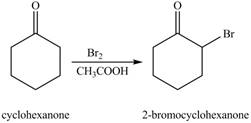
Figure 1
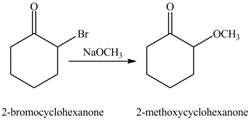
Figure 2
The first step of the reaction involves the bromination of cyclohexanone in the presence of acetic acid. It results in the formation of
The formation of the given product from cyclohexanone and organic halides having
(b)
Interpretation:
The synthesis of a given compound from cyclohexanone and organic halides having
Concept introduction:
The synthesis of the products relies upon the type of reactants and reagents that are used during the reactions. The energy of a target molecule should be low because it increases the stability of a molecule that results in the formation of a molecule with high yield. The reagents perform numerous functions in reactions like proton abstraction, oxidation, reduction, catalysis, and dehydrogenation.
Answer to Problem 23.66P
The synthesis of a given compound from cyclohexanone and organic halides having
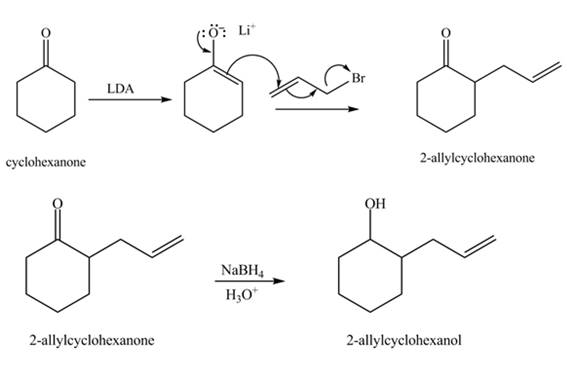
Explanation of Solution
The formation of the given product from cyclohexanone and organic halides having

Figure 3

Figure 4
The full form of LDA is lithium diisopropylamide. It is a strong base. In the first step, cyclohexanone reacts with LDA to form an intermediate, which is followed by a reaction with allyl bromide to produce
The formation of the given product from cyclohexanone and organic halides having
(c)
Interpretation:
The synthesis of a given compound from cyclohexanone and organic halides having
Concept introduction:
The synthesis of the products relies upon the type of reactants and reagents that are used during the reactions. The energy of a target molecule should be low because it increases the stability of a molecule that results in the formation of a molecule with high yield. The reagents perform numerous functions in reactions like proton abstraction, oxidation, reduction, catalysis, and dehydrogenation.
Answer to Problem 23.66P
The synthesis of a given compound from cyclohexanone and organic halides having
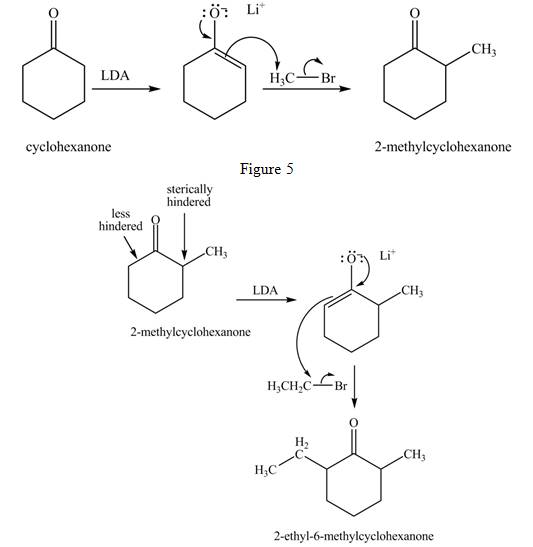
Explanation of Solution
The formation of the given product from cyclohexanone and organic halides having

Figure 5
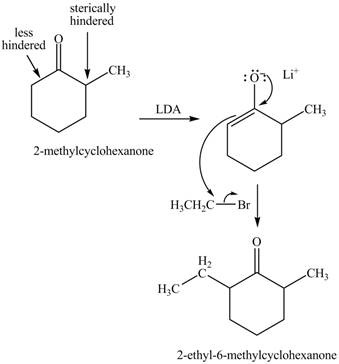
Figure 6
The full form of LDA is lithium diisopropylamide. It is a strong base. In the first step, cyclohexanone reacts with LDA to form an intermediate, which is followed by a reaction with methyl bromide to produce
The formation of the given product from cyclohexanone and organic halides having
(d)
Interpretation:
The synthesis of a given compound from cyclohexanone and organic halides having
Concept introduction:
The synthesis of the products relies upon the type of reactants and reagents that are used during the reactions. The energy of a target molecule should be low because it increases the stability of a molecule that results in the formation of a molecule with high yield. The reagents perform numerous functions in reactions like proton abstraction, oxidation, reduction, catalysis, and dehydrogenation.
Answer to Problem 23.66P
The synthesis of a given compound from cyclohexanone and organic halides having
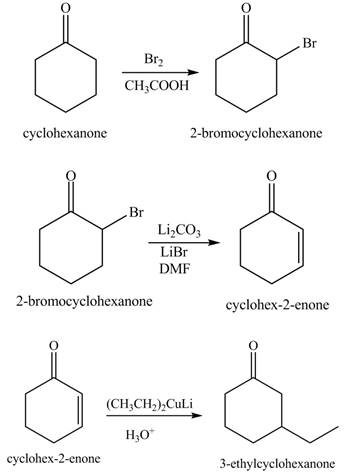
Explanation of Solution
The formation of the given product from cyclohexanone and organic halides having
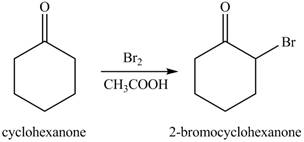
Figure 7
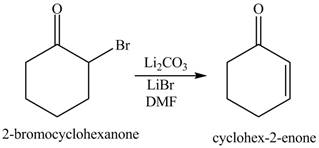
Figure 8
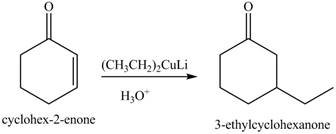
Figure 9
The first step of the reaction involves the bromination of cyclohexanone in the presence of
The formation of the given product from cyclohexanone and organic halides having
(e)
Interpretation:
The synthesis of a given compound from cyclohexanone and organic halides having
Concept introduction:
The synthesis of the products relies upon the type of reactants and reagents that are used during the reactions. The energy of a target molecule should be low because it increases the stability of a molecule that results in the formation of a molecule with high yield. The reagents perform numerous functions in reactions like proton abstraction, oxidation, reduction, catalysis, and dehydrogenation.
Answer to Problem 23.66P
The synthesis of a given compound from cyclohexanone and organic halides having
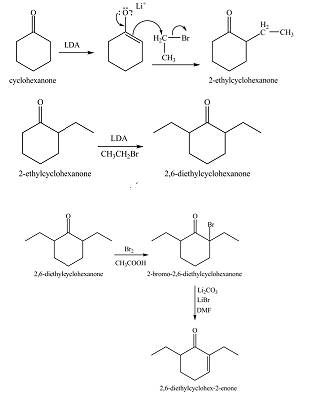
Explanation of Solution
The formation of the given product from cyclohexanone and organic halides having

Figure 10

Figure 11
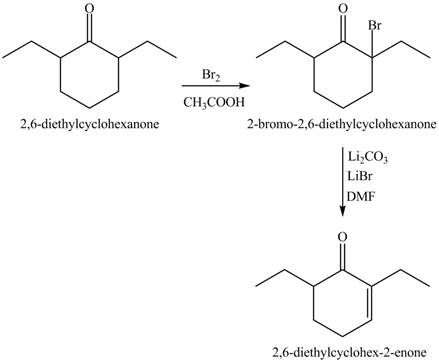
Figure 12
The full form of LDA is lithium diisopropylamide. It is a strong base. In the first step, cyclohexanone reacts with LDA to form an intermediate, which is followed by a reaction with ethyl bromide to produce
The formation of the given product from cyclohexanone and organic halides having
(f)
Interpretation:
The synthesis of a given compound from cyclohexanone and organic halides having
Concept introduction:
The synthesis of the products relies upon the type of reactants and reagents that are used during the reactions. The energy of a target molecule should be low because it increases the stability of a molecule that results in the formation of a molecule with high yield. The reagents perform numerous functions in reactions like proton abstraction, oxidation, reduction, catalysis, and dehydrogenation.
Answer to Problem 23.66P
The synthesis of a given compound from cyclohexanone and organic halides having

Explanation of Solution
The formation of the given product from cyclohexanone and organic halides having

Figure 13

Figure 14
The first step involves the bromination of cyclohexanone to give bromo product, which on reaction with
The formation of the given product from cyclohexanone and organic halides having
Want to see more full solutions like this?
Chapter 23 Solutions
Organic Chemistry-Package(Custom)
- For each reaction below, decide if the first stable organic product that forms in solution will create a new CC bond, and check the appropriate box. Next, for each reaction to which you answered "Yes" to in the table, draw this product in the drawing area below. Note for advanced students: for this problem, don't worry if you think this product will continue to react under the current conditions - just focus on the first stable product you expect to form in solution. དྲ。 ✗MgBr ? O CI Will the first product that forms in this reaction create a new C-C bond? Yes No • ? Will the first product that forms in this reaction create a new CC bond? Yes No × : ☐ Xarrow_forwardPredict the major products of this organic reaction: OH NaBH4 H ? CH3OH Note: be sure you use dash and wedge bonds when necessary, for example to distinguish between major products with different stereochemistry. Click and drag to start drawing a structure. ☐ : Sarrow_forwardPredict the major products of this organic reaction: 1. LIAIHA 2. H₂O ? Note: be sure you use dash and wedge bonds when necessary, for example to distinguish between major products with different stereochemistry. Click and drag to start drawing a structure. X : ☐arrow_forward
- For each reaction below, decide if the first stable organic product that forms in solution will create a new C - C bond, and check the appropriate box. Next, for each reaction to which you answered "Yes" to in the table, draw this product in the drawing area below. Note for advanced students: for this problem, don't worry if you think this product will continue to react under the current conditions - just focus on the first stable product you expect to form in solution. NH2 tu ? ? OH Will the first product that forms in this reaction create a new CC bond? Yes No Will the first product that forms in this reaction create a new CC bond? Yes No C $ ©arrow_forwardAs the lead product manager at OrganometALEKS Industries, you are trying to decide if the following reaction will make a molecule with a new C-C bond as its major product: 1. MgCl ? 2. H₂O* If this reaction will work, draw the major organic product or products you would expect in the drawing area below. If there's more than one major product, you can draw them in any arrangement you like. Be sure you use wedge and dash bonds if necessary, for example to distinguish between major products with different stereochemistry. If the major products of this reaction won't have a new CC bond, just check the box under the drawing area and leave it blank. Click and drag to start drawing a structure. This reaction will not make a product with a new CC bond. G marrow_forwardIncluding activity coefficients, find [Hg22+] in saturated Hg2Br2 in 0.00100 M NH4 Ksp Hg2Br2 = 5.6×10-23.arrow_forward
- give example for the following(by equation) a. Converting a water insoluble compound to a soluble one. b. Diazotization reaction form diazonium salt c. coupling reaction of a diazonium salt d. indacator properties of MO e. Diazotization ( diazonium salt of bromobenzene)arrow_forward2-Propanone and ethyllithium are mixed and subsequently acid hydrolyzed. Draw and name the structures of the products.arrow_forward(Methanesulfinyl)methane is reacted with NaH, and then with acetophenone. Draw and name the structures of the products.arrow_forward
- 3-Oxo-butanenitrile and (E)-2-butenal are mixed with sodium ethoxide in ethanol. Draw and name the structures of the products.arrow_forwardWhat is the reason of the following(use equations if possible) a.) In MO preperation through diazotization: Addition of sodium nitrite in acidfied solution in order to form diazonium salt b.) in MO experiment: addition of sodium hydroxide solution in the last step to isolate the product MO. What is the color of MO at low pH c.) In MO experiment: addition of sodium hydroxide solution in the last step to isolate the product MO. What is the color of MO at pH 4.5 d.) Avoiding not cooling down the reaction mixture when preparing the diazonium salt e.) Cbvcarrow_forwardA 0.552-g sample of an unknown acid was dissolved in water to a total volume of 20.0 mL. This sample was titrated with 0.1103 M KOH. The equivalence point occurred at 29.42 mL base added. The pH of the solution at 10.0 mL base added was 3.72. Determine the molar mass of the acid. Determine the Ka of the acid.arrow_forward
 Organic ChemistryChemistryISBN:9781305580350Author:William H. Brown, Brent L. Iverson, Eric Anslyn, Christopher S. FootePublisher:Cengage Learning
Organic ChemistryChemistryISBN:9781305580350Author:William H. Brown, Brent L. Iverson, Eric Anslyn, Christopher S. FootePublisher:Cengage Learning
